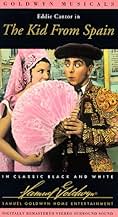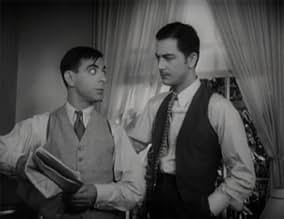Füge eine Handlung in deiner Sprache hinzuAn innocent man accused of robbing banks masquerades as a bullfighter to escape the police.An innocent man accused of robbing banks masquerades as a bullfighter to escape the police.An innocent man accused of robbing banks masquerades as a bullfighter to escape the police.
- Regie
- Drehbuch
- Hauptbesetzung
- Auszeichnungen
- 2 wins total
Robert Emmett O'Connor
- Detective Crawford
- (as Robert Emmet O'Connor)
Paul Porcasi
- Gonzales
- (as Paul Porcassi)
Jean Allen
- Goldwyn Girl
- (Nicht genannt)
Francisco Alonso
- Toreador
- (Nicht genannt)
Loretta Andrews
- Goldwyn Girl
- (Nicht genannt)
Consuelo Baker
- Goldwyn Girl
- (Nicht genannt)
Betty Bassett
- Goldwyn Girl
- (Nicht genannt)
Diane Bourget
- Goldwyn Girl
- (Nicht genannt)
Harry C. Bradley
- Man in Line at Mexican Border
- (Nicht genannt)
Empfohlene Bewertungen
I like The Kid From Spain very much, it's certainly one of Eddie Cantor's best films. But I'm still trying to figure out why in the world Sam Goldwyn borrowed Robert Young from MGM and cast him as a Mexican. Why didn't he use someone like Gilbert Roland?
Still it's Cantor's show and it begins with Eddie the schnook getting expelled from college after his pal Young puts him in the girl's dormitory where he's discovered by the Dean of Women. To his credit Young owns up to the prank and gets expelled along with Cantor. The two of them decide to go south of the border, but on the way Eddie is forced to drive a gang of bank-robbers across the border.
When American cop Robert Emmett O'Connor goes south after the robbers, the fast thinking Young introduces Cantor as a great bullfighter fresh over from Spain. Now Cantor's got to go through with it or else.
It's pretty thin stuff, but it's enjoyable and the climax with Cantor in the Corrida fighting a bull is something else. See how he overcomes the bovine challenge. Some of that business was used by Lou Costello in Mexican Hayride.
Cantor and Young pair off with Lyda Roberti and Ruth Hall and Ms. Roberti joins Eddie in singing Look What You've Done. The other song Cantor does is unfortunately in black-face and it's What A Perfect Combination. Both songs were recorded by him and sold reasonably well to Depression audiences. The score was written Bert Kalmar and Harry Ruby songwriters best known for their Marx Brothers material.
I do say though Robert Young was not a convincing Latino. He was painful to watch and I'm sure he felt more ridiculous than anyone else in the film. It's The Kid From Spain's great weakness.
Other than that, The Kid From Spain is an enjoyable film and those who want to know about the comedic art of Eddie Cantor can't do better than this film to learn.
Still it's Cantor's show and it begins with Eddie the schnook getting expelled from college after his pal Young puts him in the girl's dormitory where he's discovered by the Dean of Women. To his credit Young owns up to the prank and gets expelled along with Cantor. The two of them decide to go south of the border, but on the way Eddie is forced to drive a gang of bank-robbers across the border.
When American cop Robert Emmett O'Connor goes south after the robbers, the fast thinking Young introduces Cantor as a great bullfighter fresh over from Spain. Now Cantor's got to go through with it or else.
It's pretty thin stuff, but it's enjoyable and the climax with Cantor in the Corrida fighting a bull is something else. See how he overcomes the bovine challenge. Some of that business was used by Lou Costello in Mexican Hayride.
Cantor and Young pair off with Lyda Roberti and Ruth Hall and Ms. Roberti joins Eddie in singing Look What You've Done. The other song Cantor does is unfortunately in black-face and it's What A Perfect Combination. Both songs were recorded by him and sold reasonably well to Depression audiences. The score was written Bert Kalmar and Harry Ruby songwriters best known for their Marx Brothers material.
I do say though Robert Young was not a convincing Latino. He was painful to watch and I'm sure he felt more ridiculous than anyone else in the film. It's The Kid From Spain's great weakness.
Other than that, The Kid From Spain is an enjoyable film and those who want to know about the comedic art of Eddie Cantor can't do better than this film to learn.
Forced into Mexico by crooks, a nervous young man impersonates THE KID FROM SPAIN--an imaginary bullfighter -- to keep from getting arrested.
Follies star Eddie Cantor prances his way through this naughty pre-Code comedy. Rolling his eyes and clapping his hands, he uses every trick at his disposal to amuse and he succeeds quite nicely. Cantor never slows down, but, like a mischievous little boy, he seems forever looking for new trouble to explore. His climactic scene in the bullfighting arena remains his best remembered movie moment.
Robert Young seems an odd choice to portray a Mexican college boy, and his problematic courtship of pretty Ruth Hall is totally lacking in excitement, but fortunately it isn't given an inordinate amount of screen time. Polish comic actress Lyda Roberti makes a good foil for Cantor; her amusing face almost matches his own in stealing scenes and her singing & acting are delightfully offbeat.
The dastardly deeds are handled by two of the era's best bad guys--John Miljan as an evil matador and J. Carrol Naish as his grimy sidekick. In addition, Cantor gets to share comedy sequences with three funny fellows--Paul Porcasi as a harried border guard; beefy Noah Beery as Miss Hall's very stern papa & Stanley Fields as a dumb-as-mud killer.
Movie mavens will recognize diminutive Edgar Blueboy' Connor as a bull trainer and a young Betty Grable as one of the chorus girls--both uncredited.
Busby Berkeley directed the movie's musical production numbers, including the opening scene in a girls' dormitory, which seems to serve no other purpose than to expose a good deal of female flesh. The film's conclusion seems a bit abrupt. The villains have not been punished and the Young/Hall romance is still unresolved, but Cantor seems quite happy so why quibble?
Follies star Eddie Cantor prances his way through this naughty pre-Code comedy. Rolling his eyes and clapping his hands, he uses every trick at his disposal to amuse and he succeeds quite nicely. Cantor never slows down, but, like a mischievous little boy, he seems forever looking for new trouble to explore. His climactic scene in the bullfighting arena remains his best remembered movie moment.
Robert Young seems an odd choice to portray a Mexican college boy, and his problematic courtship of pretty Ruth Hall is totally lacking in excitement, but fortunately it isn't given an inordinate amount of screen time. Polish comic actress Lyda Roberti makes a good foil for Cantor; her amusing face almost matches his own in stealing scenes and her singing & acting are delightfully offbeat.
The dastardly deeds are handled by two of the era's best bad guys--John Miljan as an evil matador and J. Carrol Naish as his grimy sidekick. In addition, Cantor gets to share comedy sequences with three funny fellows--Paul Porcasi as a harried border guard; beefy Noah Beery as Miss Hall's very stern papa & Stanley Fields as a dumb-as-mud killer.
Movie mavens will recognize diminutive Edgar Blueboy' Connor as a bull trainer and a young Betty Grable as one of the chorus girls--both uncredited.
Busby Berkeley directed the movie's musical production numbers, including the opening scene in a girls' dormitory, which seems to serve no other purpose than to expose a good deal of female flesh. The film's conclusion seems a bit abrupt. The villains have not been punished and the Young/Hall romance is still unresolved, but Cantor seems quite happy so why quibble?
Eddie Cantor musical where a jittery simpleton is forced to cross the border to Mexico and pretend he is a matador. It's nothing special all told. Some of the jokes are funny, yes, but the whole is thin and I'm sure recycled from previous film and radio work.
What is of some interest, is that Busby Berkeley is here with his crafty engineering. Oh, both of his numbers feel tacky and have nothing to do with anything, which is more proof of zero vision behind this. Yet both numbers impress. Both are in that voluptuous mode he would cultivate in coming years: sexual tease, sparkle and shadowplay, the female body as the fulcrum of a continuously shifting erotic landscape. Eddie in blackface among Busby's radiant troupe feels crude and out of place.
He would be on to 42nd Street and history the next year.
What is of some interest, is that Busby Berkeley is here with his crafty engineering. Oh, both of his numbers feel tacky and have nothing to do with anything, which is more proof of zero vision behind this. Yet both numbers impress. Both are in that voluptuous mode he would cultivate in coming years: sexual tease, sparkle and shadowplay, the female body as the fulcrum of a continuously shifting erotic landscape. Eddie in blackface among Busby's radiant troupe feels crude and out of place.
He would be on to 42nd Street and history the next year.
Set in a girls' dormitory that looks more like a palace, it is astonishingly sexy, even by pre-code standards (you won't believe some of the innuendo they got away with); it is also one of the only two big production numbers that Busby Berkeley staged for this movie. Choreographically they're standard stuff compared to what he would do later in his career, but you can still spot glimpses of his genius. As for the rest of the movie, a very slight plot provides the framework for some funny moments (Mexican border standoff, "can you shoot me if I stand over here?", and what may be the first use of slow motion for comic purposes on the screen). **1/2 out of 4.
In the 1930s Eddie Cantor made a series of pleasant, sometimes sexy, consistently entertaining, fast paced comedies. This is, in my opinion, one of the better ones. The songs are wonderful, the gags are funny, the 1930's atmosphere is thick, and Eddie himself is so energetic throughout he seems to float.
It's a wonderful picture. Very recommended for 1930's film buffs and musical comedy enthusiasts.
It's a wonderful picture. Very recommended for 1930's film buffs and musical comedy enthusiasts.
Wusstest du schon
- WissenswertesFilm debuts of Jane Wyman, Donna Mae Roberts and Jean Allen.
- Zitate
Eddie Williams aka Don Sebastian II: [after Rosalie drops the key down her dress] ...the key to the whole situation somewhere between Tijuana and the border!
- Alternative VersionenSome existing prints have the opening titles on a simple black background, and the whole swimming pool sequence of the opening number on the first reel is cut.
- VerbindungenFeatured in London Entertains (1951)
- SoundtracksBut We Must Rise (The College Song)
(1932) (uncredited)
Music and Lyrics by Harry Ruby and Bert Kalmar
Sung and Danced by The Goldwyn Girls, including Betty Grable, Toby Wing and Paulette Goddard
Top-Auswahl
Melde dich zum Bewerten an und greife auf die Watchlist für personalisierte Empfehlungen zu.
Details
- Erscheinungsdatum
- Herkunftsland
- Sprachen
- Auch bekannt als
- Kralj arene
- Drehorte
- Produktionsfirma
- Weitere beteiligte Unternehmen bei IMDbPro anzeigen
- Laufzeit1 Stunde 36 Minuten
- Farbe
- Seitenverhältnis
- 1.37 : 1
Zu dieser Seite beitragen
Bearbeitung vorschlagen oder fehlenden Inhalt hinzufügen




































